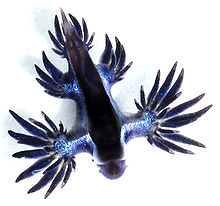| Glaucus marginatus | |
|---|---|

| |
|
Scientific classification
| |
| Domain: | Eukaryota |
| Kingdom: | Animalia |
| Phylum: | Mollusca |
| Class: | Gastropoda |
| Subclass: | Heterobranchia |
| Order: | Nudibranchia |
| Suborder: | Cladobranchia |
| Family: | Glaucidae |
| Genus: | Glaucus |
| Species: | G. marginatus
|
| Binomial name | |
| Glaucus marginatus | |
| Synonyms [1] | |
| |
Glaucus marginatus is a species of small, floating, blue sea slug; a pelagic (open-ocean) aeolid nudibranch; a marine opisthobranch gastropod mollusc in the family Glaucidae. [1] [2] This species is closely related to Glaucus atlanticus, and is part of a species complex (Informal clade Marginatus) along with Glaucus bennettae, Glaucus thompsoni, and Glaucus mcfarlanei. [3] Like Glaucus atlanticus, it is commonly known as a blue dragon. [4]
This nudibranch is dark blue, and in many ways it resembles a smaller version of Glaucus atlanticus. However, in this species the cerata are arranged in a single row in each arch.[ citation needed]
While G. atlanticus is up to 3 centimetres (1.2 in) long, G. marginate is only about 1.3 centimetres (0.51 in) long, and its tail is shorter than its cousin. The species has a light and dark blue foot. [4]
This species is pelagic, and can be found in the Pacific Ocean.[ citation needed]
While they do not usually inhabit coastal regions, hundreds of the creatures were observed washing up on one of the Sydney North Shore beaches, near Long Reef, in February 2021. [4]
These small nudibranches float upside down on the surface tension in temperate and tropical seas. They eat colonial cnidarians such as the Portuguese man o' war [2] (a.k.a. bluebottle, or Physalia utriculus), blue buttons (Porpita porpita), and the by-the-wind sailor (Velella velella). [4]
- ^ a b "Glaucus". WoRMS. World Register of Marine Species. Retrieved 5 August 2012.
- ^ a b Valdés A. & Campillo O.A. (2004) Systematics of pelagic aeolid nudibranchs of the family Glaucidae (Mollusca, Gastropoda). Bulletin of Marine Science 75(3): 381–389. [1]
- ^ Churchill C.K.C, Valdés A. & Ó Foighil D. (2014) Molecular and morphological systematics of neustonic nudibranchs (Mollusca : Gastropoda : Glaucidae : Glaucus), with descriptions of three new cryptic species. Invertebrate Systematics 28(2): 174-195. [2]
- ^ a b c d Salleh, Anna (12 February 2021). "Bizarre 'blue fleet' blows onto Australia's east coast". ABC News. Australian Broadcasting Corporation. Retrieved 13 February 2021.
- Bergh, L.S.R. (1860). Om Forekomsten af Neldefiim hos Mollusker. Vidensk. Meddel. Naturh. Foren. Kjöbenhavn, p. 309-331, pl. 8.
- Burn R. (2006) A checklist and bibliography of the Opisthobranchia (Mollusca: Gastropoda) of Victoria and the Bass Strait area, south-eastern Australia. Museum Victoria Science Reports 10:1–42.
- Australian Museum Online sections - sea slug forums
| Glaucus marginatus | |
|---|---|

| |
|
Scientific classification
| |
| Domain: | Eukaryota |
| Kingdom: | Animalia |
| Phylum: | Mollusca |
| Class: | Gastropoda |
| Subclass: | Heterobranchia |
| Order: | Nudibranchia |
| Suborder: | Cladobranchia |
| Family: | Glaucidae |
| Genus: | Glaucus |
| Species: | G. marginatus
|
| Binomial name | |
| Glaucus marginatus | |
| Synonyms [1] | |
| |
Glaucus marginatus is a species of small, floating, blue sea slug; a pelagic (open-ocean) aeolid nudibranch; a marine opisthobranch gastropod mollusc in the family Glaucidae. [1] [2] This species is closely related to Glaucus atlanticus, and is part of a species complex (Informal clade Marginatus) along with Glaucus bennettae, Glaucus thompsoni, and Glaucus mcfarlanei. [3] Like Glaucus atlanticus, it is commonly known as a blue dragon. [4]
This nudibranch is dark blue, and in many ways it resembles a smaller version of Glaucus atlanticus. However, in this species the cerata are arranged in a single row in each arch.[ citation needed]
While G. atlanticus is up to 3 centimetres (1.2 in) long, G. marginate is only about 1.3 centimetres (0.51 in) long, and its tail is shorter than its cousin. The species has a light and dark blue foot. [4]
This species is pelagic, and can be found in the Pacific Ocean.[ citation needed]
While they do not usually inhabit coastal regions, hundreds of the creatures were observed washing up on one of the Sydney North Shore beaches, near Long Reef, in February 2021. [4]
These small nudibranches float upside down on the surface tension in temperate and tropical seas. They eat colonial cnidarians such as the Portuguese man o' war [2] (a.k.a. bluebottle, or Physalia utriculus), blue buttons (Porpita porpita), and the by-the-wind sailor (Velella velella). [4]
- ^ a b "Glaucus". WoRMS. World Register of Marine Species. Retrieved 5 August 2012.
- ^ a b Valdés A. & Campillo O.A. (2004) Systematics of pelagic aeolid nudibranchs of the family Glaucidae (Mollusca, Gastropoda). Bulletin of Marine Science 75(3): 381–389. [1]
- ^ Churchill C.K.C, Valdés A. & Ó Foighil D. (2014) Molecular and morphological systematics of neustonic nudibranchs (Mollusca : Gastropoda : Glaucidae : Glaucus), with descriptions of three new cryptic species. Invertebrate Systematics 28(2): 174-195. [2]
- ^ a b c d Salleh, Anna (12 February 2021). "Bizarre 'blue fleet' blows onto Australia's east coast". ABC News. Australian Broadcasting Corporation. Retrieved 13 February 2021.
- Bergh, L.S.R. (1860). Om Forekomsten af Neldefiim hos Mollusker. Vidensk. Meddel. Naturh. Foren. Kjöbenhavn, p. 309-331, pl. 8.
- Burn R. (2006) A checklist and bibliography of the Opisthobranchia (Mollusca: Gastropoda) of Victoria and the Bass Strait area, south-eastern Australia. Museum Victoria Science Reports 10:1–42.
- Australian Museum Online sections - sea slug forums